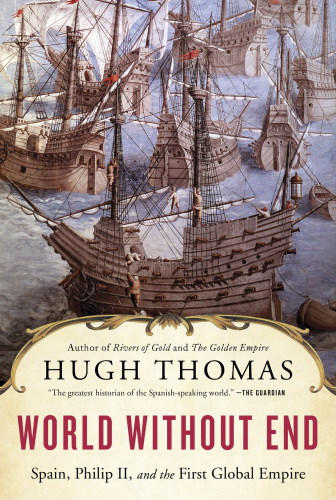
World Without End
Spain, Philip II, and the First Global Empire
کتاب های مرتبط
- اطلاعات
- نقد و بررسی
- دیدگاه کاربران
نقد و بررسی

June 29, 2015
The final installment of Thomas’s trilogy (after Rivers of Gold and The Golden Empire) completes his overview of Spain’s Golden Age–era conquests in the Americas and Asia. While he provides contextual information about Philip II’s European and colonial concerns, the emphasis remains on the vigorous conquering and colonizing of resource-laden lands to benefit Spain’s reputation and coffers. Thomas clearly excels in the Spanish history of religion, politics, and culture, but he mistakenly claims—without citation—that Philip’s desperately needy English wife, Mary I, was uninterested in him, as well as that the most recently canonized pope was Pius V (five popes have been canonized since). The inclusion of historical maps and relevant appendices helps greatly in tracing individual figures and explorations, especially when the narrative’s expansive approach and numerous tangential stories make it difficult for readers to keep track. Thomas successfully shows that Spain’s global ambition knew no bounds; the history of western Spanish colonies may be well-trod, but the discussion of initially optimistic attempts to conquer China and the Philippines will pique interest. Illus. Agency: Wylie Agency.

June 1, 2015
A celebration of Spain's prowess and reach. Award-winning British historian Thomas (The Golden Empire: Spain, Charles V, and the Creation of America, 2011, etc.) ends his trilogy on the Spanish Empire with a densely (and sometimes dizzyingly) populated, overwhelmingly detailed narrative focused on the "dedicated and cultivated" Philip II, who reigned from 1556 to 1598, during which Spain consolidated its holdings in Mexico, South America, and the Philippines. By 1600, Thomas writes admiringly, Spain "controlled the largest collection of territories the world had seen since the fall of the Roman empire." The conquest was expedited by the "valour and imagination" of conquistadors as well as the determination of missionaries, especially Jesuits, "high-minded men of intelligence capable of sacrifice, endurance, and patience," who founded an unprecedented number of schools, churches, hospitals, and convents. In contrast were some of Philip's deputies: greedy and violent, they cruelly exploited indigenous peoples and African slaves. Among the problems these administrators faced were the spread of smallpox, typhus, measles, and influenza that decimated the native population and, therefore, the workforce; internecine struggles; piracy; the threat of slave rebellion; and emigres who included vagrants, beggars, thieves, debtors, and fortune hunters hoping to loot the riches of the New World. Although most missionaries focused on education and condemned torture, some unleashed bloody punishment for idolatry. The colonial quest is no better exemplified than by Spain's bold plan to invade and conquer China, seen as "a well-managed, vast, rich land with stone-walled cities" and an easily-subdued population that "would welcome the conquerors as liberators" from the ruling Ming emperors, a comment likely to resonate chillingly with readers. Although the plan never came to fruition, Thomas suggests, "had it happened, it would surely have brought less deprivation to China than occurred under the Manchu dynasty and...the terrible communist era." A sweeping, encyclopedic history of the arrogance, ambition, and ideology that fueled the quest for empire.
COPYRIGHT(2015) Kirkus Reviews, ALL RIGHTS RESERVED.

























دیدگاه کاربران